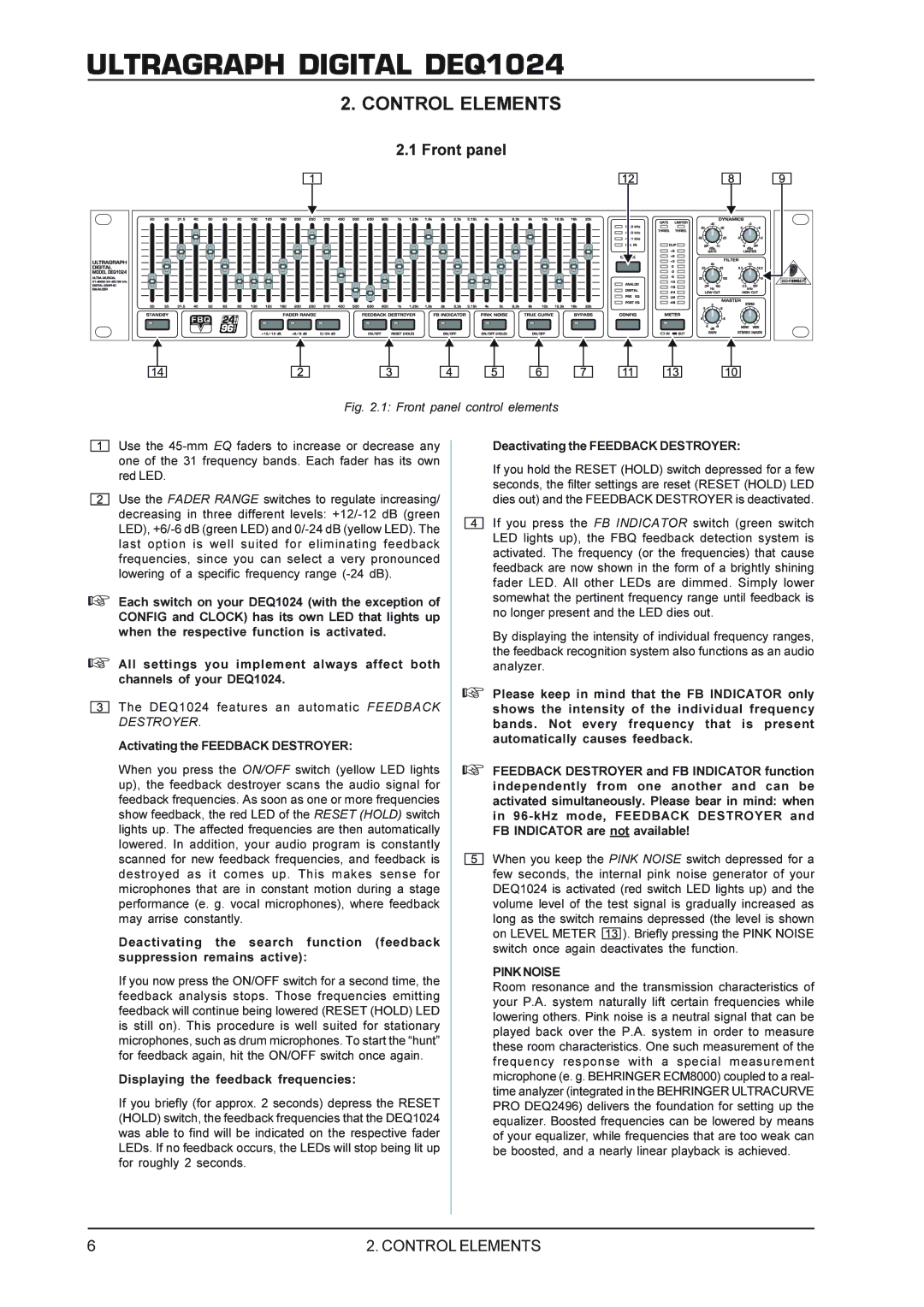
ULTRAGRAPH DIGITAL DEQ1024
2.CONTROL ELEMENTS
2.1Front panel
Fig. 2.1: Front panel control elements
Use the
Use the FADER RANGE switches to regulate increasing/ decreasing in three different levels:
+Each switch on your DEQ1024 (with the exception of CONFIG and CLOCK) has its own LED that lights up when the respective function is activated.
+All settings you implement always affect both channels of your DEQ1024.
The DEQ1024 features an automatic FEEDBACK DESTROYER.
Activating the FEEDBACK DESTROYER:
When you press the ON/OFF switch (yellow LED lights up), the feedback destroyer scans the audio signal for feedback frequencies. As soon as one or more frequencies show feedback, the red LED of the RESET (HOLD) switch lights up. The affected frequencies are then automatically lowered. In addition, your audio program is constantly scanned for new feedback frequencies, and feedback is destroyed as it comes up. This makes sense for microphones that are in constant motion during a stage performance (e. g. vocal microphones), where feedback may arrise constantly.
Deactivating the search function (feedback suppression remains active):
If you now press the ON/OFF switch for a second time, the feedback analysis stops. Those frequencies emitting feedback will continue being lowered (RESET (HOLD) LED is still on). This procedure is well suited for stationary microphones, such as drum microphones. To start the “hunt” for feedback again, hit the ON/OFF switch once again.
Displaying the feedback frequencies:
If you briefly (for approx. 2 seconds) depress the RESET (HOLD) switch, the feedback frequencies that the DEQ1024 was able to find will be indicated on the respective fader LEDs. If no feedback occurs, the LEDs will stop being lit up for roughly 2 seconds.
Deactivating the FEEDBACK DESTROYER:
If you hold the RESET (HOLD) switch depressed for a few seconds, the filter settings are reset (RESET (HOLD) LED dies out) and the FEEDBACK DESTROYER is deactivated.
If you press the FB INDICATOR switch (green switch LED lights up), the FBQ feedback detection system is activated. The frequency (or the frequencies) that cause feedback are now shown in the form of a brightly shining fader LED. All other LEDs are dimmed. Simply lower somewhat the pertinent frequency range until feedback is no longer present and the LED dies out.
By displaying the intensity of individual frequency ranges, the feedback recognition system also functions as an audio analyzer.
+Please keep in mind that the FB INDICATOR only shows the intensity of the individual frequency bands. Not every frequency that is present automatically causes feedback.
+FEEDBACK DESTROYER and FB INDICATOR function independently from one another and can be activated simultaneously. Please bear in mind: when in
When you keep the PINK NOISE switch depressed for a few seconds, the internal pink noise generator of your DEQ1024 is activated (red switch LED lights up) and the volume level of the test signal is gradually increased as long as the switch remains depressed (the level is shown
on LEVEL METER ![]() ). Briefly pressing the PINK NOISE switch once again deactivates the function.
). Briefly pressing the PINK NOISE switch once again deactivates the function.
PINK NOISE
Room resonance and the transmission characteristics of your P.A. system naturally lift certain frequencies while lowering others. Pink noise is a neutral signal that can be played back over the P.A. system in order to measure these room characteristics. One such measurement of the frequency response with a special measurement microphone (e. g. BEHRINGER ECM8000) coupled to a real- time analyzer (integrated in the BEHRINGER ULTRACURVE PRO DEQ2496) delivers the foundation for setting up the equalizer. Boosted frequencies can be lowered by means of your equalizer, while frequencies that are too weak can be boosted, and a nearly linear playback is achieved.
6 | 2. CONTROL ELEMENTS |
